
Click the icon to use the online replay facility to progress
the game move by move.
Fig 1
Black 11 simplifies the situation, for pro's too but
all the more so for amateurs this is a good strategy.
For black instead of 11 playing right to white 10 will
lead to the large-avalanche joseki. This difficult and
large-scale joseki has been around for a while already.
Go Seigen was one of the major pioneers in developing
it some 70 years ago. Recently, however, especially in
Korea different patterns of this "oonadare" are being
studied and experimented with. To feel at home with the
tens or perhaps even hundreds of variations which might
follow it goes without saying that thorough preparation
is a must.
By the way, black 11 is not a "run away from the
difficult stuff because I might get burned" kind of
move. Hikosaka sensei mentioned that for black to keep
things really simple he should play 13 at 6-4. However,
he continued to explain that although this really
simplifies the situation a lot if you now would ask 100
pro's where white is to play next all of them without
exception will come up with the move at the 11-3 point.
The game move black 13 makes it less obvious (=much
harder) to decide for white how to continue. Black 13 is
a difficult move also because it involves the risk that
somewhere along the line white might attach at the 6-3
point and aim at attacking the black stones there.

White 20 is funny looking but correct shape (although a
bit thin). White 1 in dia 1 would be
more natural looking but black is very glad to play at
2 to reinforce his stones there. White 3 next would be
normal but looking at this result it is obvious that now
a white stone at A would come out better than white 1.
The point is that because white 1 is a solid move black
is not reluctant to solidify white even more. With the
game move of white 20 however black is reluctant to do
so and instead will try to exploit white's thinness in
one or another way.
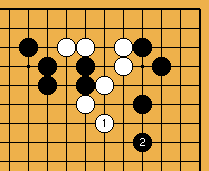
White 26 may look totally incomprehensible but Hikosaka
9p told us that most likely white decided on this
move without much for thought. "White 1 (dia
2a) may look like the most common move, better
yet, it IS the most common move but in this situation
it also is the losing move. There is no way white is
going to win this game after the 1-2 exchange." Hikosaka
sensei was very outspoken about this situation and not
only to please the crowd of about 120 people who had
gathered to watch his commentary.
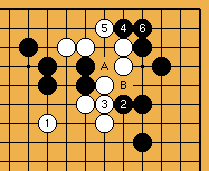
The reason for Hikosaka's bold statement is shown
in dia 2b. White 1 would be a normal
continuation but now black immediately plays 4-6 which
is worth about 10 points. Because of the troublesome
move for black at A threatening two cuts with one move,
white has no choice but to add a move at B. Though black
scored point white B is worth virtually nothing, for
pro's being made to play worthless moves like this is
a disaster. White could of course prevent black from
playing at 4 by playing in that area himself first but
this will not be a move black has to (or will) answer,
black gains the initiative and is happy. To repeat:
Black 4-6 are almost endgame moves but big since they
can be played while holding the initiative. For white
preventing black from playing there will mean losing the
initiative for the same *endgame* moves, it's much too
early in the game to justify "gote" moves for such a
small return.
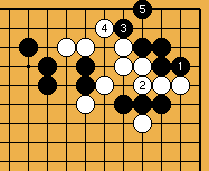
Although black 33 in the game looks like the only and
most obvious move this is not 100% the case according
to Yamashiro 9p (former challenger for the honinbo
and kisei titles) who had shown up in his usual "I'm
just out of bed and need some more coffee, thank you"
style to see for himself what was going on. The pro's
were going over dia 3 and a lot of
sidetracks when I left the ki-in about 15:30 and they
were still at it when I got back around 17:30. Note
that in fig 4 there are two defects in the white stones
which he needs to defend if he wants to move out to the
center.
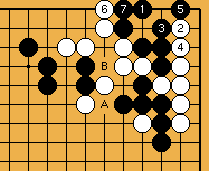
The interpreter Korean 9p Yun Ki-Han suggested that
he should instead of game move 41 black should have
played a hanging connection at the first row as shown
in dia 4 and make an eye. The black
stones are still captured but now they can easily become
a major pain in the *-* neck since the surrounding white
stones are not settled yet either. The same as before,
white has two cuts to defend against at A and B and here
he cannot hope to be able to move out to the center,
eventually white needs to come back in the corner and
manually capture the black guys.
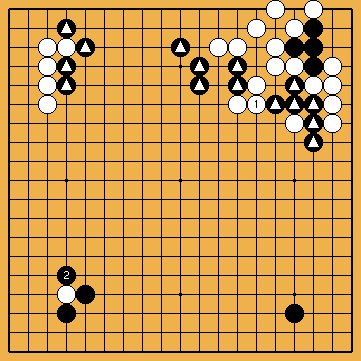
"Well, it really doesn't matter anymore, any which way
white'll choose to continue he has a good game". This
is again Hikosaka speaking during the commentary. He
himself seemed to prefer to play at 1 with white, which
is a nice and very thick move. If black goes for profit
with 2 which would be the normal thing to do the top
black stones as well as the right side stones are thin
and while attacking white should be able to solidify his
victory. Which by no means however that white's game
move 48 is bad in any way :-)
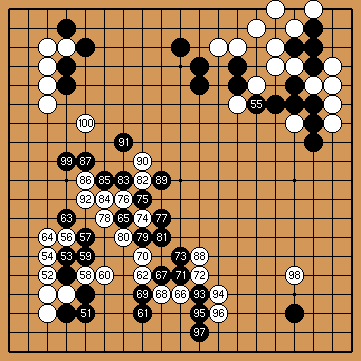
Fig 2
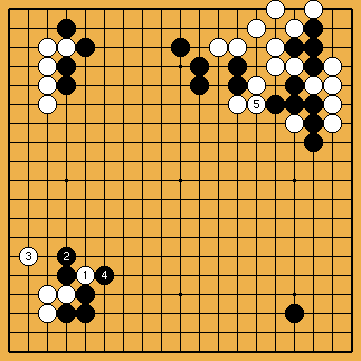
White 52 is a kind of "pushing from behind" move which
if possible one wants to avoid. It is true that it
might be necessary and even mean profit but at the same
time is also will help developing the enemy stone and
you still run the risk of being sealed in. Hikosaka
suggested the cut at 1. If black 2 white 3 is a nice
"settle and get it over with" move and if black would
play the proper reinforcement at 4 white 5 is excellent,
guaranteeing white a foothold in the center as well as
threatening to start running with 1.
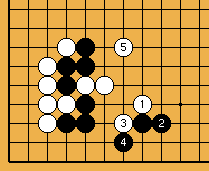
I personally found Hikosaka's comment on white 62 the
most interesting. It was clear what he was talking about
and made sense too but I never would have looked at the
situation in that way :). Hikosaka: "White 62 would
be a perfect move if black were to answer it at the
bottom with for example a knight's move. However, making
territory at the bottom at this stage of the game is not
enough for black to have a real chance of winning, so?
there's no way in hell black is gonna answer white's
move but he'll ignore the situation and force white to
come up with something thus inviting a bare-knuckled
fight! (which is a great way for black and try to turn
things around).
So, because black is reluctant to answer white 62
Hikosaka suggested dia 7. White 1 here
is a rather difficult move to ignore, it is obvious
that black faces a direct loss if he chooses to do so.
If black, for example answers at 2 white plays one more
forcing move before jumping to the vital point of the
shape at 5.
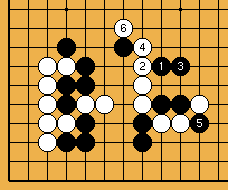
Black 73 was played to avoid something like dia
8. Black 1 looks like better shape but in this
situation white has an easy time of getting out into
the center which is very much where he wanted to be in
the first place. After black 5 white can play somewhere
around 6 and be satisfied.
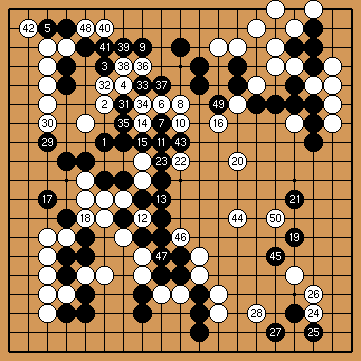
Fig 3
At this point I went to the Castle hotel to have a look
myself. Kisei Hane Naoki was the (on paper) strongest
player present in the press room but Ogata 9p was doing
the instant analyzing with the help of a energetic lady
from China who happened to be Chang Shuan (i apologize
for any spelling mistakes, this is the translation from
Japanese) and a strong pro herself. I forced myself on
the Korean delegation who fortunately didn't mind me at
all. I asked a reporter from "The Baduk Monthly" what
he thought about this game being held in Nagoya. His
response was straight to the point and very disarming:
"Well, you can have games like this in Tokyo, Osaka
or Seoul and it is all great as long as it helps to
popularize go and spread the game through the world."
All in all it was a pleasant atmosphere in the pressroom
where everybody spoke at least one common language and
that is all it takes.
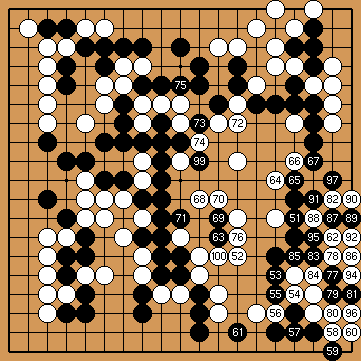
Fig 4

Fig 5
| 














